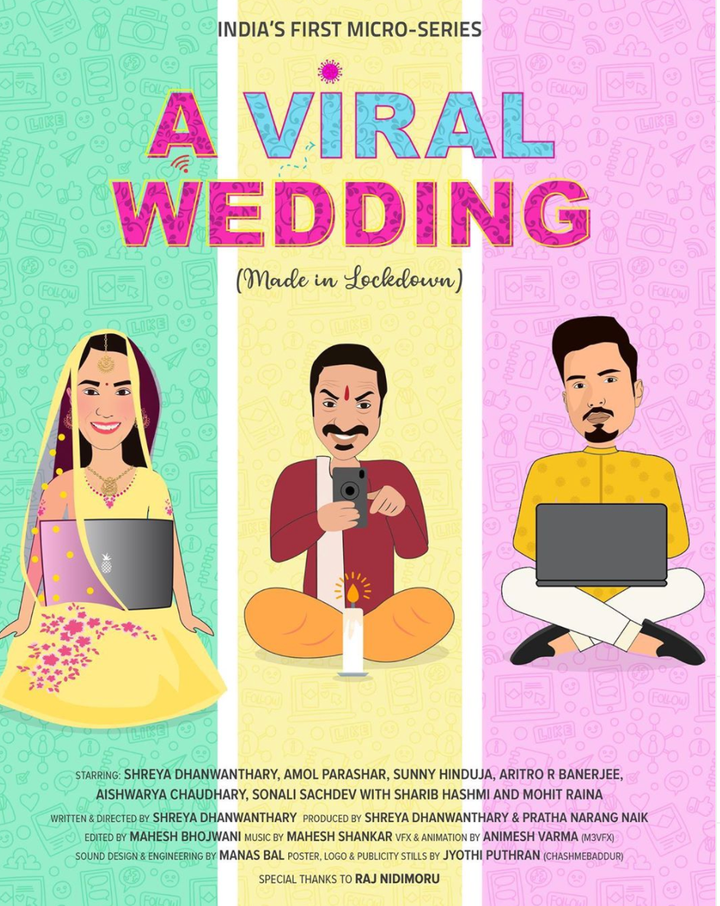
As with other industries, the coronavirus pandemic has compelled people from the Hindi film industry to come up with innovative ways to keep the show going. Raj Nidimoru and Krishna DK, the people behind films such as 99, Go Goa Gone and Stree, and most recently, the Amazon show, The Family Man, have creatively produced a ‘micro-series’ during the lockdown.
No two people involved in the production ever met physically, but the nine-part show, titled A Viral Wedding, was shot, produced, edited and is currently in the final stages of post production, Krishna DK told HuffPost India. Some of the cast members of The Family Man also feature in the micro-series, which has been remotely directed by Shreya Dhanwanthary (who played Zoya in The Family Man) and edited by Mahesh Bhojwani.
The micro-series has nine episodes, ranging from 7-10 minutes each, and is expected to stream on an online platform from next week.
“It’s like going back to our indie roots,” DK said over a phone conversation. “When you’ve to pull off your best within limited resources.”
To ensure that the film reflects the current moment, writer-director Shreya Dhanwanthary came up with the idea of adapting the theme into the narrative. The nine-episode series revolves around a couple whose marriage plans are thrown into disarray after the pandemic and ensuing lockdown. The show narrates how they manage to get hitched from afar.
“To pull this off has been extremely challenging but at the end of it, you feel a sense of accomplishment,” said Dhanwanthary over a telephonic chat.
The team of A Viral Wedding, led by Dhanwanthary, worked over Zoom calls, FaceTime and WhatsApp videos—these apps became their writer’s room, and the place where they held reading sessions and some basic acting workshops, before the shoot commenced.

And how did they shoot without any two people being in the same frame? “We laid out some basic ground-rules,” DK said. “Everybody was encouraged to shoot themselves in 4K, portrait mode, in good lighting. The iPhone cameras are pretty good so the result has been impressive, quality-wise.”
The locations, were, obviously, the respective houses of the actors.
There were plenty of occasions when the shot wasn’t upto the mark. To ensure that things stayed on course, the actors—Amol Parashar, Sunny Hinduja, Aritro Banerjee, Aishwarya Chaudhary, Sonali Sachdev, Sharib Hashmi and Mohit Raina—would shoot a clip and send it over WhatsApp to Dhanwanthary, where she’d respond with her feedback. At times, she’d stay on calls as the actors went about filming themselves.
“It was a lot of back-and-forth but eventually, a rhythm settled in. Since I’m the only one amongst all who lives alone, I was accessible when they needed me,” she said, adding that she hammered out the script for the series in a nearly 9-hour marathon session one day during the lockdown.
But wait, wouldn’t this exercise mean a lot of selfie shots? “We ensured that actors weren’t always holding the camera themselves but placed it on a tripod etc,” DK said. The team shot an episode or two a day and within a week, the shoot was over. “Think of it as actors self-directing themselves. Of course, the results weren’t always great, in which case some portions were reshot.”
The next challenge was the post-production work, which took nearly a month as the show had to be edited on home computers. But from editing, sound mixing, background score to poster design, turns out there’s very little that can’t be done if you have a steady internet connection and an iron will to stick to deadlines (objectively, the harder part).
While it’s normal for directors to meet their editors in person to give feedback, in this case, Raj-DK would write detailed notes to their editor, who’d incorporate the changes and send them the revised version.
“I’ve realised that a lot of work can be accomplished without physical meetings,” said DK, adding that he hopes that the lessons and habits picked up during the lockdown become part of a behavioural shift once the crisis blows over. “Of course, you do need face-to-face meetings but working remotely can also be very effective, as we discovered over the course of this microseries.”
Among the biggest challenges to put the series together was the coordination with actors, besides getting the tonality right as everybody had different phones with varying camera quality.
“With all the actors having to film themselves. They’re used to walking on to a set where the camera, lighting, sound etc is all set up. Now they have to do all that themselves—and all these pieces shot by different people need to come together as part of a cohesive whole.”
Dhanwanthary, the director, agreed, saying the film wasn’t just another story but also a record of the way we live and love now.
“Art imitates life, life imitates art, as they say,” she said. “And in any case, shouldn’t our current circumstances reflect in the stories we tell? It’d be a shame if it didn’t.”